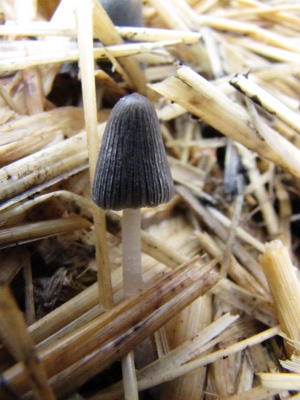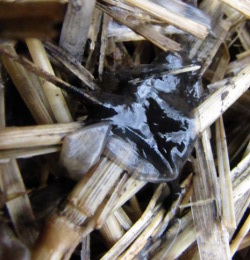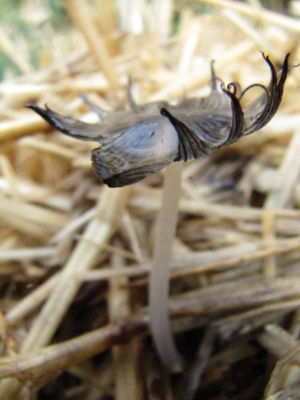
Inky cap mushrooms in the garden
 If
you've got cute, little mushrooms popping out of your straw mulch,
chances are you've grown inky caps. The aptly named inky cap
mushrooms dissolve into a mass of black goo as they mature.
If
you've got cute, little mushrooms popping out of your straw mulch,
chances are you've grown inky caps. The aptly named inky cap
mushrooms dissolve into a mass of black goo as they mature.

 Scientists
think that the life history of these mushrooms is a way of spreading
their spores more efficiently, and recent evidence suggests that
various unrelated mushrooms have come up with the same trick through
convergent evolution. Older books lump them all into one "genus"
--- Coprinus --- and I'm not enough of a
mushroom expert to tell you which of the newly split off genera my
species is actually a member of.
Scientists
think that the life history of these mushrooms is a way of spreading
their spores more efficiently, and recent evidence suggests that
various unrelated mushrooms have come up with the same trick through
convergent evolution. Older books lump them all into one "genus"
--- Coprinus --- and I'm not enough of a
mushroom expert to tell you which of the newly split off genera my
species is actually a member of.
I'm also disappointed to
discover that there doesn't seem to be much information out there about
how inky caps fit into the garden ecosystem. The fungi are
decomposers, working hard to break your straw down into compost, so I
guess that makes them beneficial (unless you were hoping not to have to
refresh the mulch this summer.) But I can't find any information
on whether inky cap inoculated straw is beneficial or harmful to garden
plants in any other way. Any ideas?
Want more in-depth information? Browse through our books.
Or explore more posts by date or by subject.
About us: Anna Hess and Mark Hamilton spent over a decade living self-sufficiently in the mountains of Virginia before moving north to start over from scratch in the foothills of Ohio. They've experimented with permaculture, no-till gardening, trailersteading, home-based microbusinesses and much more, writing about their adventures in both blogs and books.
Want to be notified when new comments are posted on this page? Click on the RSS button after you add a comment to subscribe to the comment feed, or simply check the box beside "email replies to me" while writing your comment.

My guess is that it works both ways with the inky cap family. Gardens normally benefit from mycellium forming breaking down waste, forming complex networks, and delivering nutrients. However, when a inky cap dies it can kill nearby plants. Even edible inky caps like shaggy mane will eventually go to black mode when they age causing all the nearby plants will fall over.
Love your blog.
-Mikey http://blog.holyscraphotsprings.com
This site has a personal account of dead shaggy mane killing a herb garden:
http://www.madaboutmushrooms.com/mad_about_mushrooms/shaggy-manes-101/
Another site describing lawns being killed by fairy rings, but with a overall statement about mycelia being a good thing for your yard and rarely a cause for concern.
http://www.weekendgardener.net/plant-diseases/mushrooms-090809.htm
Thanks for putting me on the right trail to finding out what mushrooms I had photographed. The inky-caps are so varied, it's no wonder I had trouble figuring it out, but yours are clearly just like mine so that was a great help. Thanks! http://www.lauriemariephotography.com/2010/02/when-hay-is-left-in-rain.html
There are several different species, so I hesitate to give you any information on the inky caps you might have in your yard. If I were you, I'd get two good edible mushroom books and make sure what you think you have matches the description in both books, then read what the books say about edibility.
I've never eaten them, but have heard that at least one species is edible, but that it reacts badly with alcohol in your body, so you shouldn't eat it if you've had any alcoholic beverages lately.
This is my first attempt at the straw bale garden and my first year of going organic. My plants started out doing great, until my first inky caps appeared. I had bought some Black Velvet mushroom compost from Lowe's and applied it around my young seedlings to help them become established. When I first found the Inky Caps, I found maybe 6 or 7 and ripped them out, straw and all, and threw them away. All the researching I did said they were okay and not to worry, because it just meant I had a lot of organic matter in my straw bales. Well, a month later and I have inky caps coming up in 10 - 40+ at a time, two to four times a day, right around base of plants. When the caps come up or fall on a plant, wherever it is touching the plant, that part of the plant withers and dies. It is non selective at to what the plant may be. I've lost numerous tomatoes, peppers, cantaloupes, squash, etc. I have never seen anything grow as fast as these things do. I have tried to pull them out, cover with newspaper and cardboard, but to no avail. They grew to full maturity under the cardboard and newspaper. I have since read that since they are a fungus, I can try a fungicide to try and get rid of them. I am at a loss of what to do, other than try an organic fungicide. I'm not at all happy with the Black Velvet mushroom compost from Lowe's. It would have been nice to know this may happen, if applied to a garden area, before finding out the hard way. I have this compost all over the tops of my straw bales, with no way of getting it off. I can't replant, because they are so numerous and fast growing. They would just kill any new plants I put in there. Very discouraged right now. I just hope I can find a remedy, before I lose my whole garden to these invasive, plant killing, Inky Cap Mushrooms!! If anyone can help me with this, I would be very grateful. God bless an I hope you have a great gardening day!
My apologies to Black Cow & Lowe's. I have found out the inky caps did not come from any item from Lowe's. They came from the straw bales I had purchased for my Strawbale Garden. After purchasing more bales, I had set them out to condition them, but never applied any compost, fertilizer, nor anything else to them. It has been raining nearly every day, for the past two weeks. Yesterday I noticed inky caps coming from under the coverings I had on them. So, I knew I had to come back and repost the truth. I have also noticed all the bales are full of chiggers! Thank God for Diatomaceous Earth! Of course, I do stand firm that, in my garden, these "Inky Cap Mushrooms" killed every plant they touched with their tops!
Hello, I've never had issue with them "killing" my plants. They also never grew so tall (4-8 inches?) as another person described. So maybe different mushrooms.
I found one reference that might be a soil indicator from people who grow other types of mushrooms (they consider it a disease to other mushrooms) which suggests they may take hold in places/circumstances of high ammonia: "is favoured by ammonia, which might have been present in compost while peak heating. black inky liquid confirms the presence of ammonia in the compost." [ https://www.researchgate.net/profile/Amit-Maurya-2/publication/342313176_Important_Diseases_and_Pests_of_Mushroom/links/5eecbef4458515814a6ad7d6/Important-Diseases-and-Pests-of-Mushroom.pdf ]
In which case it could also be the heat and ammonia killing your plants and these mushrooms decomposing it also.?
In theory they might help remediate the ammonia over time if it is not so severe as to affect your plants???
Otherwise unfortunately I have not seen anything else regarding their benefits/detriments in our gardens. Or ecological role besides decomposer. Several on micoremediation of heavy metals for mining but I'm assuming you don't have that problem in your garden.